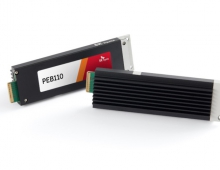
Elpida Develops 25nm Process DRAM
Elpida Memory today announced it had developed a 2-gigabit DDR3 SDRAM using a 25nm process for memory manufacturing.
Using the advanced process technology available Elpida claims that it has has achieved the industry's smallest chip size for a 2-gigabit SDRAM.
The new 25nm DRAM process technology requires 30% less cell area per bit compared with Elpida's 30nm process. The chip output for a 2-gigabit DDR3 SDRAM wafer using the new process is about 30% higher versus 30nm.
The new SDRAM is an eco-friendly as it contributes to lower energy consumption by PCs and digital consumer electronics. It outperforms Elpida's 30nm process products by saving on electric current (15% less operating current and 20% less current when on standby).
At the time the 25nm process was developed the structural changes required to shift from a 30nm process were minimized to hold down the capital expenditure needed for ramping up 25nm volume manufacturing.
By the end of 2011 Elpida also plans to begin volume production of 4-gigabit DDR3 SDRAM products using the 25nm process. Compared with the 30nm process a 44% increase in chip output per wafer is expected for this 4-gigabit DDR3 product. In addition, the new 25nm process will be used to support further development of Mobile RAM, Elpida's mainstay memory product.
The 25nm process 2-gigabit DDR3 SDRAM can support performance above DDR3-1866 (1866Mbps) and is compliant with low-voltage 1.35V high-speed DDR3L-1600 (1600Mbps).
Both sample shipments of the new 25nm 2-gigabit DDR3 SDRAM and volume production are expected to begin in July 2011.
Features
Part Number: EDJ2104BFSE / EDJ2108BFSE
Manufacturing Process: 25nm CMOS
Memory Density: 2G-bit
Data Width: x4-bit / x8-bit
Data Transfer Rate: 1866Mbps and higher
Supply Voltage (VDD): 1.5V, 1.35V (Low voltage)
Operating Case Temperature Range (TC): 0 to 95°C
The new 25nm DRAM process technology requires 30% less cell area per bit compared with Elpida's 30nm process. The chip output for a 2-gigabit DDR3 SDRAM wafer using the new process is about 30% higher versus 30nm.
The new SDRAM is an eco-friendly as it contributes to lower energy consumption by PCs and digital consumer electronics. It outperforms Elpida's 30nm process products by saving on electric current (15% less operating current and 20% less current when on standby).
At the time the 25nm process was developed the structural changes required to shift from a 30nm process were minimized to hold down the capital expenditure needed for ramping up 25nm volume manufacturing.
By the end of 2011 Elpida also plans to begin volume production of 4-gigabit DDR3 SDRAM products using the 25nm process. Compared with the 30nm process a 44% increase in chip output per wafer is expected for this 4-gigabit DDR3 product. In addition, the new 25nm process will be used to support further development of Mobile RAM, Elpida's mainstay memory product.
The 25nm process 2-gigabit DDR3 SDRAM can support performance above DDR3-1866 (1866Mbps) and is compliant with low-voltage 1.35V high-speed DDR3L-1600 (1600Mbps).
Both sample shipments of the new 25nm 2-gigabit DDR3 SDRAM and volume production are expected to begin in July 2011.
Features
Part Number: EDJ2104BFSE / EDJ2108BFSE
Manufacturing Process: 25nm CMOS
Memory Density: 2G-bit
Data Width: x4-bit / x8-bit
Data Transfer Rate: 1866Mbps and higher
Supply Voltage (VDD): 1.5V, 1.35V (Low voltage)
Operating Case Temperature Range (TC): 0 to 95°C





















